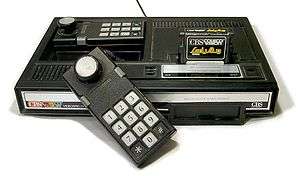ColecoVision

The Colecovision was one of the more powerful systems of its era when Coleco Toys introduced it in late 1982. In fact, it was actually much closer to the Nintendo Entertainment System in terms of overall power than any of its competitors in the pre-Crash video game market. It was expandable, had a fast CPU and a Texas Instruments GPU with its own video memory, and had a decent assortment of attachments (at least on paper). It's probably more famous now for being the machine that brought the first truly faithful port of Donkey Kong to the home user, and for getting sued by Atari over the "Expansion Module", basically an Atari 2600 in a box that could attach to a port on the console.
Like the Intellivision, the Colecovision used a controller that combined a joystick with a 12-key keypad (which allowed games to include overlays to show how the buttons would be used). Unlike the Intellivision however, the controllers were detachable and could be replaced by third-party alternatives.
The Colecovision did well initially, and Coleco decided to take things further by introducing the ADAM, a full PC based on the Colecovision's motherboard (by way of a daughterboard in a plastic case). ADAM was sold as a complete word-processing system, a big deal in 1983, and as such it shipped with a built-in text editor (which ran on startup), a full-size, full-travel keyboard, a daisy-wheel printer (which the power cord ran through), and a "datapack" drive that used a proprietary, modified cassette tape. It also had a serial peripheral bus called ADAMNET; despite appearing 3 years before Apple's ADB system, its potential was never fully explored and only the keyboard and printer ever used it.
The ADAM could be obtained by itself (in which case it had a Coleco cartridge port), or, at least on paper, as an attachment to an existing Colecovision. The ADAM was rushed to meet the Christmas 1983 shopping season (which it failed to do—it was closer to January 1984), and its launch was fraught with problems. The power supply had a high failure rate, and the tape drives were poorly shielded and would erase the tape if not treated with care.[1]
Most of the extra software and peripherals Coleco promised for the ADAM never surfaced. However, third-party support for the ADAM was surprisingly large. A new external power supply meant the noisy, slow daisy-wheel printer could be replaced. Floppy drives could be added, and faster modems could be used.
The Colecovision had very few exclusive games, partly due to lasting only two years in production, partly because Coleco continued to release games for the Atari 2600 and Intellivision as well as for their own console. (Atari, for their part, released a few games for the Colecovision under the Atarisoft label.) Most of its game library consisted of ports of arcade games, though these conversions usually turned out better than the versions produced for competing consoles.
Both the Colecovision and the Coleco ADAM were quickly discontinued after The Great Video Game Crash of 1983 killed the market. Coleco itself quickly followed them; while they had a huge hit with the Cabbage Patch Kids dolls in 1984, they eventually lost the license and sold themselves to Hasbro in 1989.
Specifications
- The main processor was the venerable (and, in 1983, still quite formidable) Zilog Z80, running at 4 MHz. The ADAM added several Motorola 6801s for running the keyboard, printer and tape drives.
- Both systems used the same GPU, the TI 9928, which was also used in MSX consoles and (in slightly improved forms) in the Sega Master System and Sega Genesis.
- Sega's SG-1000, the ancestor of both the Master System and Genesis, was virtually identical to the Colecovision, to the extent that at least one clone console could play both Colecovision and SG-1000 cartridges.
- The main CPU was somewhat starved of RAM unless you had ADAM, but both systems had a very generous 16K of dedicated VRAM, making them two of the most powerful consoles of their time.
- ADAM itself had a full complement of 64K, as well as two different operating systems in ROM. (Or one OS and a word processor.)
- Used a TI three-channel programmable sound generator, the same as in TI's own machines and the IBM PCjr, and similar in capabilities to the GI/Microchip AY-3-89xx used by the Intellivision and MSX.
Games available for the Colecovision included
- Antarctic Adventure
- Artillery Duel
- Boulder Dash
- Buck Rogers Planet of Zoom
- Burger Time
- Cabbage Patch Kids: Adventures in the Park (a Licensed Game based on the toy line sold by Coleco at the time)
- Centipede
- Chuck Norris Superkicks
- Congo Bongo
- Defender
- Donkey Kong
- Frenzy
- Frogger
- Frogger II: Threeedeep!
- Galaxian
- Gorf
- Gyruss
- Jungle Hunt
- Lady Bug
- Miner 2049er
- Mr. Do
- Mr. Do!'s Castle
- Pitfall!
- Pitfall II: Lost Caverns
- Popeye
- Q Bert
- Q*Bert's Qubes
- River Raid
- Rocky Super Action Boxing
- Smurf: Rescue in Gargamel's Castle
- Space Panic
- Star Wars the Arcade Game
- Super Cobra
- Tapper
- Time Pilot
- Turbo (packaged with steering wheel and gas pedal controllers)
- Tutankham
- WarGames (a tie-in to the film)
- Zaxxon
- ↑ Those tapes were also more fragile than normal cassette tapes; the bodies were made of Lexan, the same stuff Compact Discs are made of, and Lexan is a lot more brittle than the ABS plastic most cassettes were made from in the 1980s.